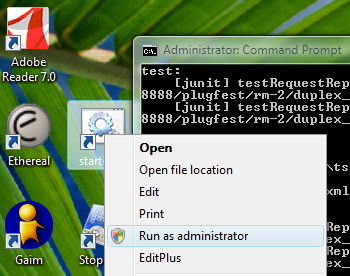Running Java on Vista RC2, some tips...
As days go by, I am able to get more and more done on my desktop, but still to figure out how to get the productivity increase, as I was initially expecting from a modern OS.
The last issues that I was facing was IPv6 vs. IPv4, and I have now been able to google the resource that explain it all: "The Cable Guy - October 2005" on MSDN, especially the 'Disabling IPv6' section.
Unless you disable IPv6 on all interfaces, you will have to change your way to start java process. Here is my new way to launch JUnit tests from ant:
<junit showoutput="true" fork="yes">
<jvmarg value="-Djava.net.preferIPv4Stack=true">
...
I had to use the same option when starting the server-side process for my J2EE container. As this is not exactly lightweight, I'll have to find a better way forward (most likely hack with the registry as advised by the Cable Guy). For some reason, I was expecting to find such information from the new integrated search features...
Next, you will need to check the properties for the files and directories created when you unzip a file in place, using the embedded feature that come with Vista. All the files are read-only by default.

Last is the permission required to run any java process. I used to have a bunch of batch files pre-cooked to start my processes with different option (debug, verbose, ...), and keep all those shortcut on my desktop. Now, I am back to Linux land and need to remember to 'sudo' so that the process has enough privilege to do his job. In Vista, it's called "Run as administrator".
When you have the cmd windows opened, remember to check the title bar every time you run into any failure during the execution of your processes or tests. I am still used to the double-click on my desktop icons instead of the 'right-click + run as' required.

Hope you will find this useful and that it will save you some time and frustration.
-- Ecco
The last issues that I was facing was IPv6 vs. IPv4, and I have now been able to google the resource that explain it all: "The Cable Guy - October 2005" on MSDN, especially the 'Disabling IPv6' section.
Unless you disable IPv6 on all interfaces, you will have to change your way to start java process. Here is my new way to launch JUnit tests from ant:
<junit showoutput="true" fork="yes">
<jvmarg value="-Djava.net.preferIPv4Stack=true">
...
I had to use the same option when starting the server-side process for my J2EE container. As this is not exactly lightweight, I'll have to find a better way forward (most likely hack with the registry as advised by the Cable Guy). For some reason, I was expecting to find such information from the new integrated search features...
Next, you will need to check the properties for the files and directories created when you unzip a file in place, using the embedded feature that come with Vista. All the files are read-only by default.

Last is the permission required to run any java process. I used to have a bunch of batch files pre-cooked to start my processes with different option (debug, verbose, ...), and keep all those shortcut on my desktop. Now, I am back to Linux land and need to remember to 'sudo' so that the process has enough privilege to do his job. In Vista, it's called "Run as administrator".
When you have the cmd windows opened, remember to check the title bar every time you run into any failure during the execution of your processes or tests. I am still used to the double-click on my desktop icons instead of the 'right-click + run as' required.

Hope you will find this useful and that it will save you some time and frustration.
-- Ecco
Comments